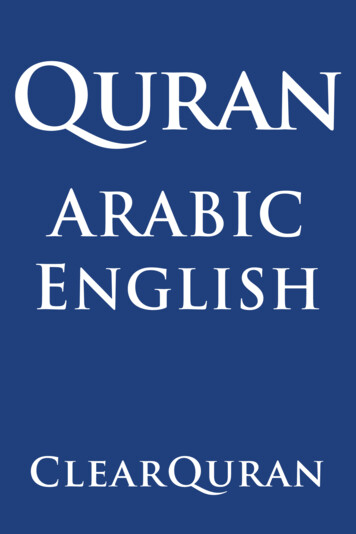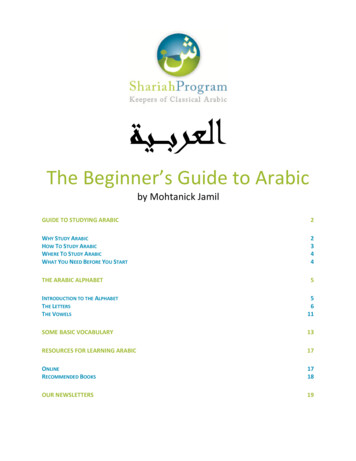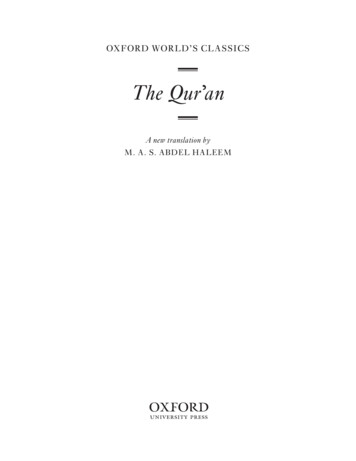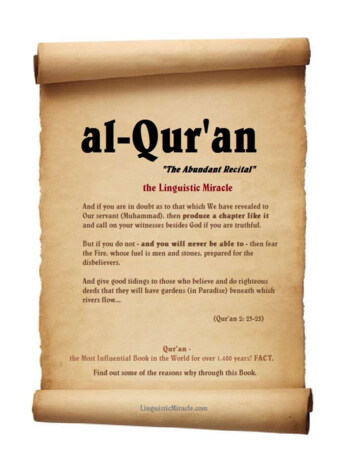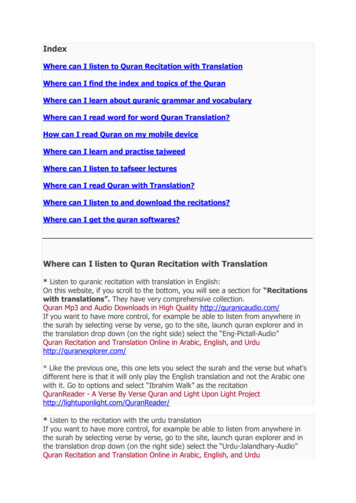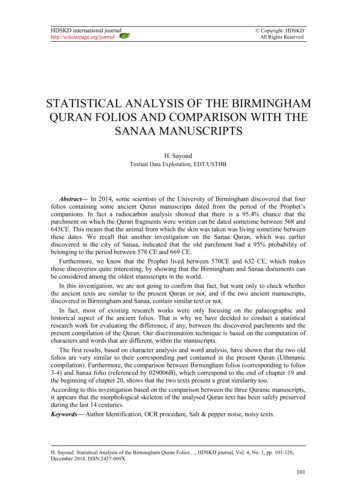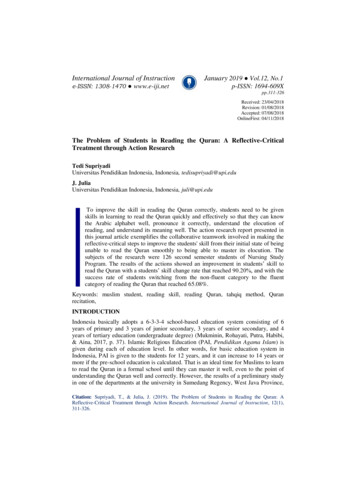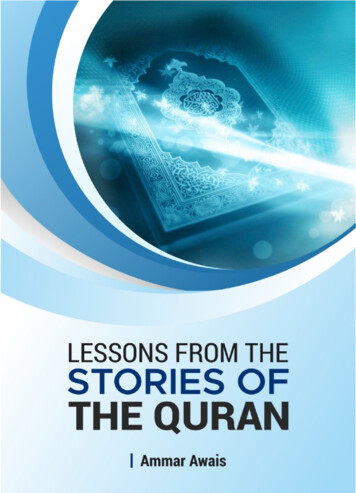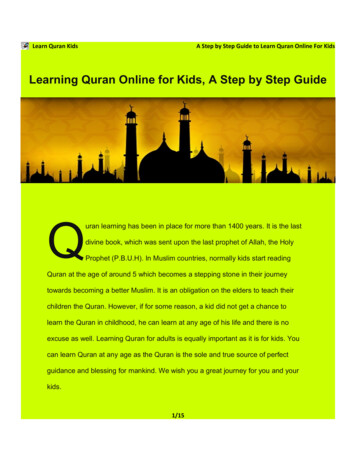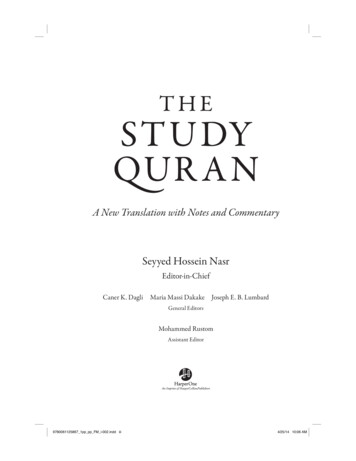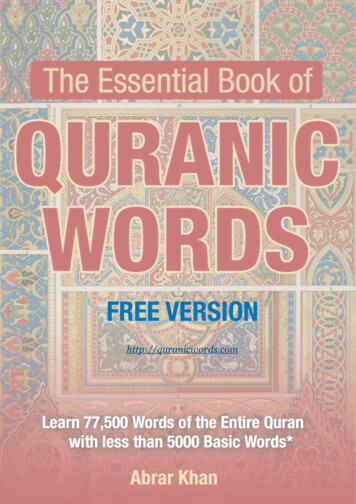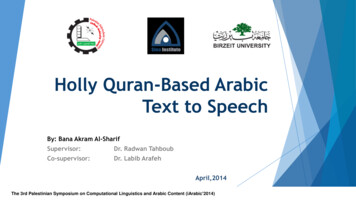
Transcription
Holly Quran-Based ArabicText to SpeechBy: Bana Akram Al-SharifSupervisor:Dr. Radwan TahboubCo-supervisor:Dr. Labib ArafehApril,2014The 3rd Palestinian Symposium on Computational Linguistics and Arabic Content (iArabic'2014)
Outline Introduction Our System Description Evaluation To Do Procedure2
Introduction
TTS History [18] As a mechanic machine (1003) Gerbert of Aurillac : "speaking heads“ (1198-1280) Albertus Magnus, and (1214–1294) Roger Bacon: Improvement in “speakingheads” (1779) Christian Kratzenstein: Vocal tract that could produce the five long vowel sounds. (1930) Bell Labs: Vocoder (voice coder)Electrical Speech Synthesizer 1939 Voder(1939) Homer Dudley: voder (Voice Demonstrator)Speech Synthesis by computers (1970- up to now): concatenating (phones – diphones – etc.) Since 10 years the English TTS development has greatest improvements, the challenge isto satisfying limited resource consumption (memory and CPU)[2]Deutsches Museum (vonMeisterwerken derNaturwissenschaft undTechnik) in Munich,Germany(Wolfgang vonKempelen)
Arabic TTS History The formal language in more than 24 countries[16,17] The fourth spoken language in world [17] Special and big religious value by being the language of the Holly Quran formore than 1.6 billion Muslims .[7] Speech synthesis by concatenating sub-syllabic sound unitsEl-Imam, Y.A. Publication Year: 1987 [7] 17 years after the birth of computers In 1997 publishing SAMPA (Speed Assessment Method Phonetic Alphabet)increase the interest in the ATTS[7]
Special properties in Arabic TTS Diacritic Arabic language considered as regular spelling language incomparison with French and English. [1][5][11] Milestones: Corpus (data base) Intonation and rhythm Prosodic
Comparison (Researches) From IEEE ( recorded in April,10,2014)ArabicEnglish*Text to speech1083594011Tts1041654Text to voice11451012Speech synthesis532858056voice synthesis9451861 19177515594 English has about 4 times Arabic * is 82 times Arabic
TTS “At the present state of the art, the limits of the achievableintelligibility and naturalness of synthetic speech are no longerset by technological factors, but rather by our limitedknowledge about the acoustics and the perception of speech. Inresearch, speech synthesis is used to test this knowledge.”[28] Science field: [2]Artificial intelligence (AI) Computer science Natural Language processing science Algorithms (searching the corpus)
Typical TTS Components[2][5]PreprocessingText AnalysisDiacriticplain text,QuranLetter to soundruleDatabase forexceptionalwordsPhoneticDictionary Pronunciation RulesSyllabificationStress Rule andprosodygeneratorNatural Language its)DigitalSignalProcessingModuleSynthesized Speech
Our System Description
Characteristics in Holy Quran The input text is from Holy Quran The output speech is a reciter's reading for verses Recitation full of features[13] Pure rule-based. [5,7] The Prosody are defines by Tajweed Rules. No breathing calculation No abbreviation, No annotation, No accents.[13] Well recorded speech for big data quantity, suitable forlearning and testing
Our System chine LearningSynthesizedSpeech
Build the diphones for theData Base We use the spectrogram ofthe signal to determine thediphones and cut it, thentranslating by CELPparameters, after that saveit in a text file with its label. Programs Goldwave, PraatHumanSpeechGoldwave/ CoolEditDiphones
SyllabificationTextPhonetization phoneticExample Phonetic symbols withprosody and stress levelinformation[3]) حيم ِ الر ِ َّ م الل ِ س ْ الر ْ ِ )ب َّ من َّ ه ِ ح Bis mil la:hir raX ma:nir raXi:m (CVV CVV:CVC:CVC CVV CV CVV CV:CVV CV CVC:CV CVV CVC) CVV(WS) CVV(PS):CVC(PS):CVC(WS) CVV(SS) CV(WS) CVV(PS) CV(WS) :CVV(WS) CV(WS) CVC(PS):CV(WS) CVV(WS) CVC(PS).PhoneticSymbols
Classification/ clusteringLabelingDiphonesDataBase Concatenating the units from the database oflabeled speech needs effective way, some used Comprehensive Classificationcc,vv,.etc.searchingand clustering dependent on syllableIndexingcriteriaMachineLearning
Classification/ 10010111000010َ ب َ ب َ ب َ ب با بو بي Indexingcriteria00100We suggest a data structure( like table) contains all Diphones and arranged as shown:The first 5 bits (from left) point to the phonemic symbol (as in SAMBA table)MachineThe rest 3 bits point to the syllable, prosody.LearningUsing 8 bits we have indexed 256 entry.So as ِ ب in بسْ م we already know that its in 00011010If this tested and proved, it will be the first, otherwise statistical model(machinelearning) is an alternative
CELPDiphonesCELPEncoding DataBaseanalyzer Code Excited Linear Prediction (CELP) CELP Coding is ananalysis by synthesis technique. The idea behind analysis-bysynthesis at the encoder is to analyze a short-time frame (ormore) of speech, and extract parameters from this. Theseparameters are then used to create a frame of reconstructedspeech. Sample rate at 8 kHz, the frame size is 20 ms 160 samples), and the block duration for the excitation sequence selection is 5 ms (40 samples). 40* 1024 matrix: creating the Gaussian codebook 10 bits index, 8 bits pith filter, 12 bits LPC parameter (inverse sine), 3 bits thegain, 7 bits for pitch filter coeffCELPDecodingSynthesizer
CELP Experiment ResultsSpeech sample بسم هللا الرحمن الرحيم بس مل ال هر رح ما نر رحي م 655Frame #147131518131216112410Max 680.14t-shift(originalsynthesized)0000000000
CELP, original signal and synthesizedsignal
Evaluation
Evaluation Is a novel contribution in our thesis at the level of ATTS inconcept and in the TTS synthesis in the criteria A high quality text to speech system should producesynthesized speech whose spectrograms should nearlymatch with the natural speech.[22]
Evaluation (signal processingparameters) cross-correlate signals to determine if there is a match, deal with data difference not timedifference Time delay and maximum/minimum amplitude Covariance of signal : A measure of how much the deviations of two or more variables orprocesses match. (cov α similarity) Spectral coherence identifies frequency-domain correlation between signals. mean square error and spectral distances. The spectral distances are defined by diff Simulink.sdi.compareSignals(signalID1,signalID2) to find the data match and the tolerance
MFCC[21]
MFCC : Feature Extraction Extracta feature vector from each frame 12MFCCs (Mel frequency cepstral coefficient) 1normalized energy 13 features DeltaMFCC 13 Delta-Delta Total:MCC 1339 features39 Feature vector25
ComparisonFor Evaluation we have MFCCfor the original signal & the MFCC for thesynthesized one With mathematical differences between MFCC’s willreflect the naturalness taking into account the signalprocessing parameters: cross-correlate, Covariance ofsignal, Max Amplitude, mean square error and spectraldistances, and maximum amplitude for each.The percentage for each parameter is not determined yet.
To Do procedure Implement a mini-database for diphones, selecting theverses is important.Fix the index procedure and test it, by decode some fromthe Gaussian codebook in some order.Determine the percentage for evaluation parameters.Evaluate our system and others.
Bibliography1.Al-Ghamdi M et all, "Phonetic Rules in Arabic Approach", accepted in 2002, م ، مجلة جامعة الملك سعود 16 ص ص ، علوم الحاسب و المعلومات ،1-25 الرياض ،(1424 \ه 2004 )م 2.Al-Saud N. and Al-Khalifa H., "An Initial Comparative Study of Arabic Speech Synthesis Engines in iOS and Android", iiWAS2012, 3-5 December, 2012,Bali, ACM 4113.Assaf M., “A prototype of an Arabic Diphone Speech Synthesizer in Festival”, Master Thesis, 20054.Black A. and Taylor P., "Automatically Clustering Similar Units For Unit Selection In Speech Synthesis", 1997, The Festival Speech Synthesis System:system documentation. Technical Report HCRC/TR-83.5.Chabchoub A. et all, "Di-Diphone Arabic Speech Synthesis Concatenation", International Journal of Computers & Technology. Council for InnovativeResearch: www.ijctonline.com ISSN: 2277-3061International Journal of Computers & Technology: Volume 3. No. 2, OCT, 20126.Dey S. et all, "Architectural Optimizations for Text to Speech Synthesis in Embedded Systems", 1-4244-0630-7/07/ 20.00 2007 IEEE.7.El-Imam Y., "Phonetization of Arabic:rules and algorithms", Science Direct, accepted in 2003, Computer Speech and Language 18 (2004) 339–3738.Elothmany A., "Arabic Text-To-Speech Including Prosody (ATTSIP) for Mobile Devices", AlQuds University , 20139.Elshafie A, "Automaticall Y Clustering Similar Units For Unit Selection In Speech Synthesis toward an Arabic Text to Speech", 1991, The Arabian Journalfor Science and Engineering. Volume 16, Number 4B.10.Fulcher j. et all, "A Neural Network, Speech-based Approach to Literacy", 200211.http://en.wikipedia.org/wiki/Text-To-Speech accessed on 1/3/201412.http://www.azlifa.com/pp-lecture-8/ accessed on 20/4/201313.Ibrahim N., "Automated Tajweed Checking Rules Engine For Quranic Verse Recitation", Phd thesis, 201014.Odeh N., "Diphone-Based Arabic Speech Synthesizer for Limited Resources Systems", AlQuds University, Fall 2012,2013
Bibliography15.Sarma Ch. et all, "A Rule Based Algorithm for Automatic Syllabification of a Word of Bodo Language", 2012, IJCCN, ISSN 2319-272016.Sassi S. et all, "A Text to Speech System for Arabic Using Neural Networks", ISSN :1098-7576, ISBN:0-7803-5529-6, IEEE pages 3030 - 3033 vol.5, 199917.Sassi S. et all, "Neural Speech Synthesis System for Arabic Language using CELP18.Springer D.,”An Introduction to Text to Speech Synthesis”, Book, ISBN 1-4020-0369-2 , 200119.Tabbal, H., et all, 'Analysis and Implementation of a “Quranic” verses delimitation system in audio files using speech recognition techniques',Proceeding of the IEEE Conference of 2nd Information and Communication Technologies, 2006. ICTTA ’06.Volume 2, pp. 2979 – 298420.Zhang M et all, "Phoneme Cluster Based State Mapping Fortext-Independent Voice Conversion", 978-1-4244-2354-5/09/ 25.00 2009 IEEE, ICASSP gital Signal Processing/Summer13/DSP 13 Chap6.pdf22.Speech Technology - Kishore Prahallad (skishore@cs.cmu.edu)23.Anees I. et all, “Al-Aswat Al-Arabia”, 199024.Elshafei M. etall, “Tichniques for high quality Arabic Speech Synthesis”, Elsevier Science 200225.Elshafie A. et all,” Toward an Arabic Text-To-Speech system.” The Arabic Journal Science and Engine, 1991.26.Abu Alyazeed M. et all, “Comparison of Syllables and Sub-Syllable Methods for Speech Synthesis”, 198927.Abu Ghattas N. and Abdel Nour H., “Text-to-Speech Synthesis by Diphones for Modern Standard Arabic”, An-Najah Univ. J. Res. (N. Sc.), Vol. 19, 200528.Elshafei M. etall, “Tichniques for high quality Arabic Speech Synthesis”, Elsevier Science 2002Algorithm", ISBN:0-7695-1165-1 , IEEE pages (119 – 121) 2001
Thanks for listening
Arabic TTS History The formal language in more than 24 countries[16,17] The fourth spoken language in world [17] Special and big religious value by being the language of the Holly Quran for more than 1.6 billion Muslims .[7] Speech synthesis by concatenating sub-syllabic sound units El-Imam, Y.A. Publica
